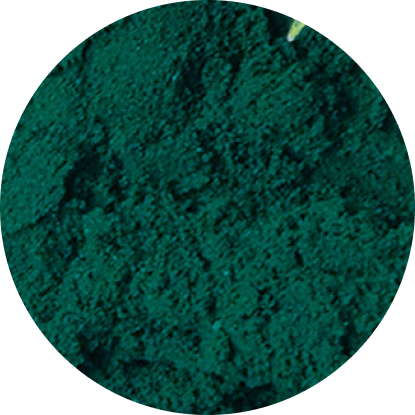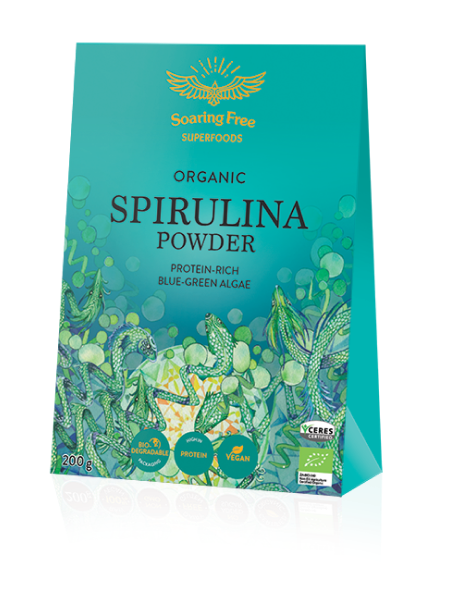SPIRULINA INSIGHTS
SPIRULINA, THE MOST NUTRIENT DENSE FOOD ON THE PLANET
View spirulina product
What is Spirulina?
Spirulina is one of hundreds of algae species known as blue-green algae (cyanobacteria). Its name derives from the spiral or helical nature of its structure. Spirulina’s claim to fame is it’s successfully used by NASA as a dietary supplement for astronauts during space missions. Unlike many other plants, spirulina creates proteins and sugars in the same way as animals do. The concentration of protein, minerals, vitamins and phytonutrients has led many to classify spirulina as “the most nutrient dense food on the planet.”
This green gem naturally grows in alkaline lake water in warm regions like Mexico, where it has been nourishing locals for over 5,000 years. In fact the Aztecs commonly dried it and ate it on tortillas. The Africans of the Sahara region also enjoyed a good plate of dried spirulina with grains and vegetables.Its rapid growth makes it a sustainable food crop, which has led to a recent boom in spirulina farms around the globe.
Spirulina has been found to exhibit and plethora of beneficial functions including antioxidant, anti-bacterial, antiviral, anticancer, anti-inflammatory, anti-allergy and anti-diabetic qualities. Plus its consumption also appears to promote the growth of beneficial intestinal micro-flora. There are no official daily guidelines for spirulina, but 3000mg a day is a popular recommendation.
FATIGUE
Fatigue is becoming far too common and many of us need all the help we can get to repair cellular damage and replenish energy reserves. It appears that spirulina may increase ones buffer against mental and physical fatigue. The polysaccharides(Rhamnose and Glycogen) and essential fat (GLA) present in spirulina can be absorbed easily by human cells helping to increase energy levels. Spriulina feeds the friendly lactobacillus bacteria in the gut, enabling the production of Vitamin B6, which is needed for energy production.
A randomized, double blind, placebo controlled study showed a statistically significant increase in exercise output after 1 week of taking3 grams of spirulina a day. Mental performance improved four hours after supplementation and continued to increase for eight weeks of the trial. These results clearly show that spirulina is a worthwhile support for fatigue.
EXERCISE PERFORMANCE
Every active person is looking for that magic pill that will increase his or her performance. Well spirulina might well be it. Supplementation resulted in a significant increase in exercise performance, fat oxidation, and GSH concentration and attenuated the exercise-induced increase in lipid peroxidation, according to a paper published in the journal Medicine and Science in Sport and Exercise.
ANAEMIA
Anemia is not uncommon for omnivores and vegetarians alike and the results can be harrowing. The most visible pigment in Spirulina is chlorophyll, a green molecule common to plants. It releases ions when struck by the energy of sunlight. Chlorophyll and blood are both constructed of a molecule called pyrrole rings, raising the question, is chlorophyll good for blood? In a 2011 study published in the journal Cellular and Molecular Immunology researchers found after 12 weeks of spirulina supplementation 30 men and women demonstrated a steady increase in hemoglobin.
IMMUNITY
Today our immune systems need all the help they can get! Many studies exist that suggest spirulina may boost the immune system and help protect against allergic reactions such as rhinitis. According to a 2011 study spirulina has the ability to modulate immune functions and exhibits anti-inflammatory properties by inhibiting the release of histamine. The spleen and thymus glands also show enhanced function, plus macrophages, T-cells and natural killer (NK) cells exhibit enhanced activity following Spirulina administration.Spirulina also enhances the body’s ability to generate new blood cells therefore increasing ones immune system and general health.
FATTY LIVER DISEASE
Owing to the popularity of foods rich in sugar and refined carbohydrates, nonalcoholic fatty liver disease (NAFLD) has become increasingly common.If left untreated NAFLD will usually lead to insulin resistance and metabolic syndrome. According to a resent study spirulina has been found to enhance insulin sensitivity and appears to have considerable potential for controlling the oxidative stress associated with NAFLD. This could be because phycocyanobilinis a phytochemical inhibitor of NAPDH oxidase. According to a 2014 studypublished in the Annals of Gastoenterology, “Spirulina supplementation at a high dosage of 6g daily in NAFLD patients has strong and multiple beneficial metabolic effects and improves their health-related quality of life.”
DIABETES
Diabetes type-2 has officially hit epidemic proportions worldwide. Interestingly spirulina has been shown to possess antihyperglycemic (blood sugar lowering) andantihyperlipidemic (blood fat lowering) properties. In a 2004 study the efficacy of spirulina supplementation (2g a day for 2 months) resulted in an appreciable lowering of fasting blood glucose and indicated improved long-term glucose regulation.Triglyceride levels were significantly lowered along with LDL cholesterol and HDL cholesterol levels normalized.“These findings suggest the beneficial effect of spirulina supplementation in controlling blood glucose levels and in improving the lipid profile of subjects with type 2 diabetes mellitus.”
INFLAMMATION
Inflammation is the word hot on the lips of all integrative doctors today. And there is very good reason for that. Research has now found inflammation lies at the foundation of all chronic diseases. One of the major mechanisms in chronic inflammation is oxidative stress. In a 2015 study researchers found spirulina reduced inflammation and protected against oxidative damage in joint tissue, as well as increasing mobility and assisting body temperature regulation.
The protection afforded by spirulina against the development of chronic inflammation is due to its antioxidant activity. Results of animal studies suggest that spirulina may increase the production of anti-inflammatory chemicals known as interferons and interleukins. Plus phycocyanin, a protein found in Spirulina, expresses potent anti-inflammatory activity partly through inhibition of pro-inflammatory cytokine formation. Phycocyanin is also a free radical scavenger and has significant protective effects on the liver. An interesting study found a spirulina diet given to lactating rat mothers can protect against neuroinflammation in the brains of suckling pups.
WEIGHT BALANCE & BLOOD PRESSURE
Hypertension and obesity are two of the most common disorders in the world. Both of which are considered major risk factors for cardiovascular disease. “This study demonstrates that three months of regular consumption of Spirulina maxima not only improves BMI and weight but also results in improvements in blood pressure and endothelial function in overweight patients with hypertension.”
CHOLESTEROL
Cholesterol is a major topic of concern for many westerners. What we do know is that hyperlipidemia and inflammation contribute to the development of atherosclerotic lesions (tears in the artery walls). In a 2015 study on mice,12 weeks of spirulina supplementation proved to decrease the development of atherosclerotic lesions, suggesting that it may be used as a natural product for atheroprotection.In a randomized double-blind placebo-controlled study in Korea, 78 individuals aged 60–87 years were randomly assigned in a blinded fashion to receive either spirulina or placebo. After 16 weeks of consuming 8g of spirulina a day, a significant plasma cholesterol-lowering effect was observed.Phycocyanin is a water-soluble protein found in abundance in spirulina. Ingestion of phycocyanin preparation resulted in a significant decrease in serum total cholesterol and atherogenic index whereas serum HDL cholesterol, which was too low, concurrently increased.
ALLERGIES
With lowered immune systems and damaged gut bacteria, allergies have become ‘a dime a dozen’. According to a recent review on the effects of spirulina on allergies, “The prevalence of allergic diseases such as asthma, atopic dermatitis, and allergic rhinitis has increased during the last two decades.”Thankfully spirulina appears to block the release of histamine from mast cells during an allergic reaction acting as a safe and natural antihistamine. Spirulina also reduces muscle contraction, blood vessel expansion, and stomach acid production during allergic reactions.
The antibody known asimmunoglobulin-E (IgE) may also be one indicator of an allergic response.In many studies dietary supplementation with spirulina seemed to help high levels of IgE return to near normal levels. Studies also show that a high dose of spirulina significantly reduces the inflammatory cytokine interleukin-4 (IL-4) by32%.
ANTI-CANCER
Taking the world by storm cancer has catalyzed a great wave of fear amongst westerners. This ellusive disease has left doctors and scientists baffled for decades. A multi pronged approach is now being promoted by many experts and spirulina may be a useful element to help prevent as well as support the healing of cancer.
A way in which spirulina may help to fight cancer is by promoting the release of tumor necrosis factor alpha, a natural chemical in the body that attacks tumor cells. It is surmised to potentiate the immune system leading to suppression of cancer development. In humans Spirulina acts directly on myeloid lineages and either directly or indirectly on natural killer cells. In several laboratory studies on animals, spirulina supplementation prevented the development and spread of induced cancers. When extracts of spirulina were injected into already existing cancerous tumors in animals, the tumors stopped spreading and some even disappeared.
Spirulina appears to assist the repair of DNA, as well as providing antioxidant protection from reactive oxygen species (ROS) generated during normal or abnormal metabolism and from toxic substances in the environment. Both of which are helpful for healing cancer.
More recent studies have shown that the calcium spirulan (Ca-Sp); a sulfated polysaccharide of blue-green algae) of Spirulina can assist in the inhibition of tumors and metastasis. Research suggests that Ca-Sp reduces lung metastasis of melanoma cells by inhibiting the tumor invasion of the basement membrane.
Breast Cancer
The COX enzyme, which are involved in prostaglandin synthesis, are over expressed in many breast cancer cells. Of major interest to ongoing research in inflammation as well as breast cancer is the finding that c-phycocyanin selectively inhibits cyclooxygenase-2 (COX-2).
Ovarian Cancer
A 2015 study looked at the effects of phycocyanin on human ovarian cancer after 48 hours of exposure. The apoptosis rate (cancer cell death) increased from 1.6% to 19.8% after exposure to phycocyanin.
Pancreatic Cancer
Spirulina is rich in tetrapyrrolic compounds such as phycocyanobilin, which are closely related to bilirubin molecule, a potent antioxidant and anti-proliferative agent. In a 2014 study spirulina significantly decreased proliferation of human pancreatic cancer cell compared to untreated cells.“These effects were at least partially due to their potent antioxidant activity, inhibition of mitochondrial production of ROS and subsequent changes in intracellular redox status. These data support a chemopreventive role of this edible alga with promising potential for its broad use in the chemoadjuvant treatment of cancer diseases. This assumption of more generalized use of S. platensis in cancer chemoprevention is supported also by recent data demonstrating anti-cancer potential of this alga on liver as well as breast carcinogenesis.”
DIGESTIVE SUPPORT
The high concentration of chlorophyll in spirulina has shown a marked improvement on digestive issues. Chlorophyll promotes peristaltic action in the intestines and thus relieves constipation. It also helps to normalize the secretion of digestive acids. Chlorophyll also soothes inflammation and reduces excess pepsin secretion associated with gastric ulcers.Spirulina is a fantastic food for beneficial intestinal flora, especially Lactobacillus and Bifidus. Maintaining a healthy population of these bacteria in the intestine reduces the likelihood of pathogenic bacteria such as E.coli and Candida albicans from taking hold. Beneficial bacteria are the main component in good digestion and make up 80% of the immune system. Not only does it feed the good guys but spirulina also exhibits potent antibacterial activities against pathogenic bacteria. Spirulina given to animals results in clearance of E.coli and Staphylococcus aureus, both pathogenic bacteria.
ANTI-VIRAL
Viruses are still challenging medical scientists today. In laboratory cultures and animal studies spirulina has been shown to have important anti-viral activity. It appears to block the entrance of viral cells into host cells. When administered at a low concentration it results in reduced viral replication and at higher concentrations it was able to completely block replication. Several viruses were killed or damaged by spirulina in recent clinical trials. Spirulina extract has been shown to inhibit viral cell-penetration and replication of the Herpes Simplex Virus Type 1 (HSV-1). Researchers propose that regular consumption of algae may help prevent or lessen infections by viruses including cytomegalovirus, pseudorabies virus,measles, mumps and influenza. It may even be helpful in preventing the progression of the HIV virus within the body.
Spirulina is a fantastic food for beneficial intestinal flora, especially Lactobacillus and Bifidus. Maintaining a healthy population of these bacteria in the intestine reduces the likelihood of pathogenic bacteria such as E.coli and Candida albicans from taking hold. Beneficial bacteria are the main component in good digestion and make up 80% of the immune system. Not only does it feed the good guys but spirulina also exhibits potent antibacterial activities against pathogenic bacteria. Spirulina given to animals results in clearance of E.coli and Staphylococcus aureus, both pathogenic bacteria.
RADIOPROTECTIVE
Spirulina appears to protect against cell damage caused by radiation. Plus it is also a good scavenger for a variety of free radicals. In a 2012 study researchers found the increase in oxidative stress markers and the concomitant change in antioxidant levels indicate the role of oxidative stress in radiation-induced tissue damage. “It was concluded that administration of Spirulina algae possess a radio protective capacity against ionizing-radiation induced oxidative stress and organ injury.”
HEAVY METAL PROTECTION
Oxidative damage to the liver and kidneys is a common result of lead toxicity and other heavy metal poisoning. In an experiment to measure the protective effects of spirulina against lead acetate the results showed that Spirulina maxima prevented the significant lead acetate-induced changes on plasma and liver lipid levels and on the antioxidant status of the liver and kidney. Spirulina succeeded in improving the biochemical parameters of the liver and kidney back towards a normal state.
MUSCLE PROTECTION
There is no question that exercise is important to health, but it is important the body is able to properly recover after intensive exercise. Studies suggest spirulina supplementation could prevent skeletal muscle damage during exercise. Plus the activity of blood superoxide dismutase (SOD) was significantly raised after supplementation with spirulina.“These results suggest that ingestion of S. platensis showed preventive effect of the skeletal muscle damage and that probably led to postponement of the time of exhaustion during the all-out exercise.”
CHILDHOOD NOURISHMENT
Malnutrition is a global issue especially in children and spirulina could be an easy and affordable solution. After malnourished children were fed 10g of spirulina a day for one month along with normal meals, the weight-for-age scores and weight-for-height scores increased significantly. At day 15, there was a statistically significant difference between the level of total proteins, and albumin measured in both groups, in favour of the spirulina group. This study found that the nutritional status of undernourished children who received Spirulina supplements improved quickly and significantly.Spirulina is a primary source of vitamin A precursors known as carotenoids. The body naturally synthesizes vitamin A from carotenoids, such as beta-carotene. Unlike vitamin A supplementation, carotenoid supplementation cannot reach toxic levels. Spirulina is a very good dietary source of beta-carotene. After children were fed 2g or 4g or spirulina a day for 10 weeks, serum beta-carotene concentrations in children increased by up to 160 times. Total-body vitamin A stores also increased significantly.
EYES
If we had the opportunity, every one of us would do what was needed to ensure lasting eyesight. The antioxindant zeaxanthin, found in spirulina, appears to reduce the risk of cataracts and age-related macular degeneration according to a 2012 study. While the vitamin A content gives our eyes the acuity they need.
KIDNEY STONES
Spirulina could be helpful in preventing kidney stones. Phycocyanin protects the kidneys against oxidative stress damage triggered by oxalate. In a 2014studyresearchers found phycocyaninpre-treatment showed significant protection to mitochondria and increased ATP (energy) production in cells. They concluded that phycocyanin could be used as a potential free radical-scavenging therapeutic strategy against oxidative stress-associated diseases including urolithiasis.
NUTRIENT DENSITY
Essential Fatty Acids
Spirulina contains specific essential fatty acids (EFA) that aid in prostaglandin function, which is necessary for hormonal balance and blood pressure regulation (also important for pregnancy). These EFA’s are linoleic acid, gamma-linolenic acid (GLA), linolenic and arachidonic acid.These essential fatty acids are also involved in cell respiration, and are especially important to oxygen transport. They are needed for healthy hair, skin and nails, and help break up cholesterol in the blood stream.
Proteins
The body needs protein to conduct its primary tasks such as cellular repair, building tissue and hormone production. Spirulina is thought to contain the highest quality protein available. This green superfood is a complete protein source boasting all 9 essential amino acids. Interestingly it contains the most protein when harvested in the early daylight, totaling 50-70% of its total dry weight. The main amino acids present are leucine, valine and isoleucine.
Minerals
Minerals are at the core of all cellular processes. Spirulina grows best in waters saturated with mineral deposits from ancient soils and mountains. In fact the mineral density is so high no other plants can live there. During its growth spirulina incorporates and synthesizes many minerals and derivative compounds into its cell structure. During the growth process spirulina transforms the inorganic minerals into a bioavailable form for the human body.
Spirulina contains a good dose of iron, magnesium, potassium, manganese and copper as well as a top up of calcium, phosphorus, selenium, sodium, zinc and chromium.
Vitamins
Our DNA, brain and liver are just a few areas of the body that need vitamin B to function. Our adrenals, thyroid and reproductive organs crave vitamin C, while our immune system needs vitamin A, C and E to keep us healthy. Spirulina contains numerous vitamins such as B-complex vitamins (B1-thiamine, B2-riboflavin, B3-niacin, B5-pantothenic Acid,B6-pyridoxine, B12-cobalamin), folate, vitamin A, vitamin C, and vitamin E (tocopherol), biotin and inositol.
Antioxidants
Antioxidants are an essential part of our diet. They have the important function of protecting cells from damage caused by oxidation (rusting), a chemical process that occurs when food is broken down or toxins attack the cell. According to several studies spirulina boasts high antioxidant activity.
The antioxidants in spirulina include beta-carotene, alpha-carotene, lutein,zeaxanthin,xanthophylis, chlorophyll-a, xanthophyll, echinenone, myxoxanthophyll, canthaxanthin, diatoxanthin, 3′-hydroxyechinenone, beta-cryptoxanthin and oscillaxanthin, plus the phycobiliproteins c-phycocyanin and allophycocyanin.
Proteins
Spirulina is approximately 65 to 71 percent protein, depending on growing conditions. Not only are these ratios high, but they are also biologically complete, which means they provide all eight essential amino acids in the proper proportions. Plus these amino’s are in a bioavailable form meaning they are incredibly easy to assimilate compared to animal products. This is unusual for a plant food. The body needs the eight essential amino’s for repair and maintenance. Unfortunately, the body cannot store amino acids in anticipation of future deficiency.All essential amino’s must be present simultaneously for the major work to occur.
Spirulina also contains high concentrations of non-essential amino acids including valine, alanine, arginine, aspartic acid, cystine, glutamic acid, glycine, histidine, proline, serine and tyrosine.
WHY QUALITY IS KEY
Since spirulina is known for its ability to absorb toxins it needs to be grown in a clean environment. Spirulina can easily be contaminated with toxic substances called microcystins as well as heavy metals,which may be present in the water where it is grown. Therefore one needs to be rather picky when it comes to choosing the brand of spirulina.




